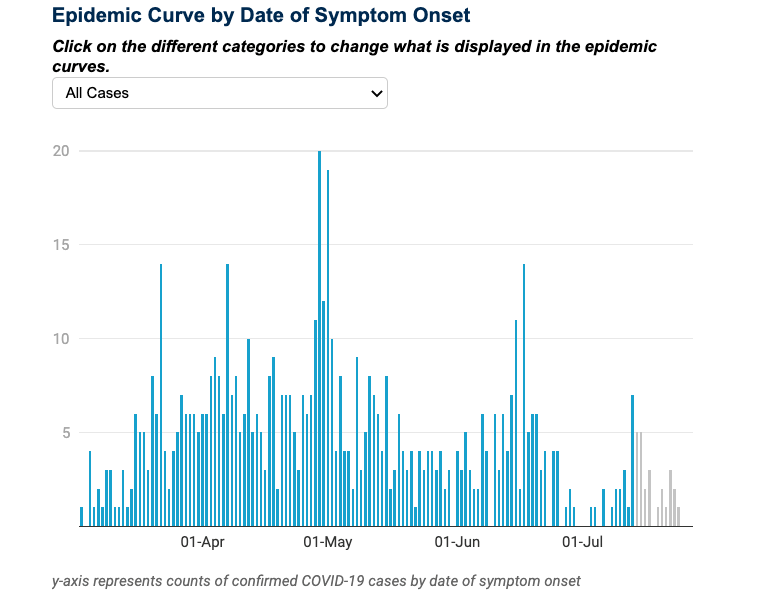With nearly five months on a corona-coaster ride, the hills and valleys of COVID-19 have been felt in the Simcoe-Muskoka region.
Dr. Charles Gardner, medical officer of health for Simcoe Muskoka District Health Unit, has observed a lower rate of disease in the region, but a similar trajectory when it comes to new cases, the ages people involved in those cases, and even the geographical trends of how the virus spreads.
After reporting six new cases of COVID on Monday, including four cases in Bradford, the health unit reported zero new cases today.
“We’ve had a bit of a bumpy road with control and resurgence,” said Gardner. “It’s really all up to us again … the potential for resurgence is real.”
The health unit has reported 15 new cases of COVID since July 21, including a staff member and resident at a retirement residence in Penetanguishene. The resident, a woman over the age of 80, is hospitalized in an intensive care unit.
The week of July 19, the health unit reported 19 cases. For the week of July 12, the health unit reported 18 cases. Graphs showing the epidemic curve in the region roll up and down; there have been as many as 24 new cases reported on a single day.
Currently, the reproductive rate for Simcoe-Muskoka is 1.1, meaning every person who tests positive for the virus is passing it on to 1.1 other people. When the reproductive number is above one, it means the infection rate is growing. The reproductive number for the region has been as high as 2.25 on July 8 and as low as .22 on June 26.
But the virus doesn’t appear to be spreading equally around the region. Of the 652 cases confirmed by the health unit, 621 have been in Simcoe County, with just 31 total cases confirmed in Muskoka District.
Within Simcoe County there are also gradients. The City of Orillia, for example, has the lowest incidence rate with 53.8 cases per 100,000 people in the population and 18 cases to-date.
Bradford West Gwillimbury has the highest incidence rate in the region with 300 cases per 100,000 people for a total of 129 cases in the municipality. However, Bradford is the southernmost municipality in the region and shares a border with York Region Public Health, which has reported 3,235 COVID cases and has a cumulative incidence rate of 263.9 cases per 100,000 compared to 109.7 cases per 100,000 for Simcoe-Muskoka.
There was also a long outbreak at Bradford Valley Care Community, which resulted in the deaths of 12 residents. In total, there have been 55 institutional outbreak-related cases reported in Bradford. There have also been four workplace-related cases.
“I think it correlates well with the north-south gradient provincially,” noted Gardner. “Within the province, you see a higher incidence the farther south you go.”
The average incidence rate in Ontario is currently 261.8 cases per 100,000 of population. Peel Region has a rate of 405 cases per 100,000 people and Toronto has a rate of 452 cases per 100,000 people. Windsor-Essex is the highest with 525.6 cases per 100,00 people. That region has seen a big surge in cases related to agriculture workplace outbreaks.
“Within Simcoe-Muskoka, there’s a much higher rate of disease in Simcoe versus Muskoka, and within Simcoe there’s a gradient north-south as well,” Gardner said.
While Barrie has the most number of cases of all the municipalities in Simcoe County (an even 200 cases), it’s Bradford and New Tecumseth that top the list for incidence rate. New Tecumseth has had 81 cases for an incidence rate of 195 cases per 100,000 in the population.
Innisfil has a rate close to Barrie’s at 130 cases per 100,000 to Barrie’s 134 cases per 100,000.
Partly due to the north-south gradient provincewide, Gardner has been working with municipalities from the start of the pandemic to come up with ways to protect residents and limit the number of people gathering in popular day-trip or weekend vacation spots.
Early in the pandemic, Gardner pushed a message asking people to stay away from their cottages for a while.
Lately, he’s had his eye on the region’s beaches and has stressed to each municipality they should implement measures to reduce the number of people on the beach, whether through parking or access.
Many municipalities have started charging for parking or increased parking fees as a result, and that has drawn harsh criticism from Ontario Premier Doug Ford, who called the practice price gouging.
“We have been successful in keeping our incidence rate down,” said Gardner. “Municipalities have been working hard … to come up with various ways to control numbers and encourage people to space out.”
Charging extra for parking for those visiting from outside the municipality lines up with that objective, according to the doctor.
“These are the ways they are seeking to achieve that public health goal,” Gardner said. “They are consistent with what we’ve been recommending.”
Gardner is urging the residents of Simcoe County and Muskoka to remain vigilant about infection-control measures, such as physical distancing, handwashing and wearing a face covering indoors. He also said people should take their social circles “very seriously” and make sure it is an exclusive group of 10. If you are meeting anyone outside the group, he said you should be outdoors and adhering to physical distancing.
“There have been places where they’ve been able to achieve sustained zero (new cases),” said Gardner. “That would be wonderful to achieve, but at this point in time, what is most important is that we don’t lose control of the pandemic.”
There may be times where the region sees small surges, particularly as more things reopen, but Gardner says he would like to see those be short durations.
“We want to minimize surges … ideally, we would have a downward trajectory,” he said.
You can visit the Simcoe Muskoka District Health Unit website for more health stats related to COVID-19 cases in the region.



